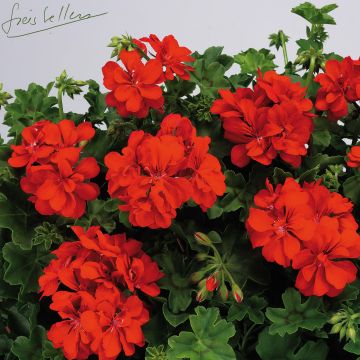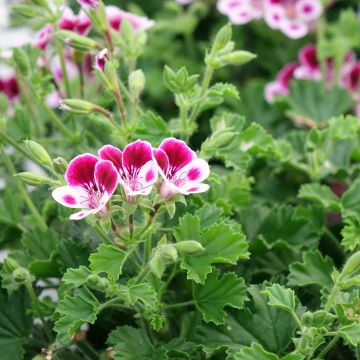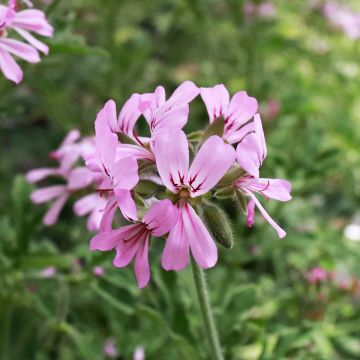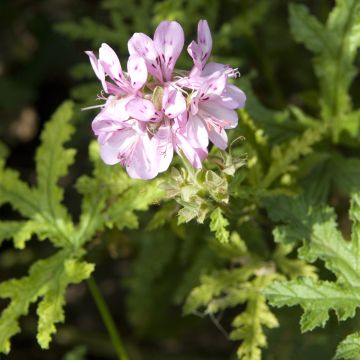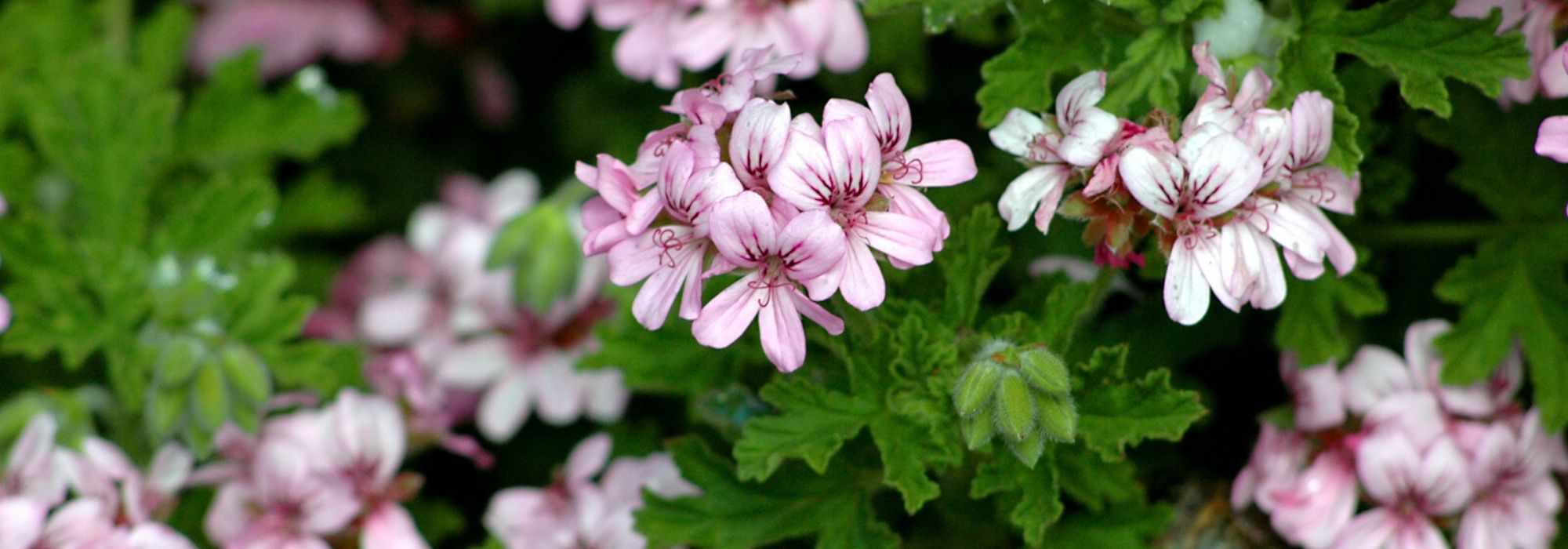

Pelargonium Bermuda Cherry - Géranium des fleuristes
Pelargonium Bermuda Cherry - Regal Geranium
Pelargonium x domesticum Bermuda Cherry
Regal Geranium, Martha Washington Geranium, Lady Washington Geranium
Condition of the plants is absolutely fine. Thank you.
roland D., 20/04/2018
Special offer!
Receive a €20 voucher for any order over €90 (excluding delivery costs, credit notes, and plastic-free options)!
1- Add your favorite plants to your cart.
2- Once you have reached €90, confirm your order (you can even choose the delivery date!).
3- As soon as your order is shipped, you will receive an email containing your voucher code, valid for 3 months (90 days).
Your voucher is unique and can only be used once, for any order with a minimum value of €20, excluding delivery costs.
Can be combined with other current offers, non-divisible and non-refundable.
Why not try an alternative variety in stock?
View all →This plant carries a 6 months recovery warranty
More information
We guarantee the quality of our plants for a full growing cycle, and will replace at our expense any plant that fails to recover under normal climatic and planting conditions.

Would this plant suit my garden?
Set up your Plantfit profile →
Description
The Pelargonium 'Bermuda Cherry' is a revamped version of the florist's geranium. It bears large two-tone and fringed flowers that somewhat resemble pansies or gloxinias; they open to reveal a wide white throat with red stamens, and are extensively bordered with a vibrant cherry pink. The plant blooms very early in the season, and its flowers continue to appear for a long period on its beautiful spreading bright green foliage. A bushy and compact variety, ideal for small gardens, verandas, hanging baskets, and planters.
Florist's pelargoniums, also known as large-flowered geraniums or even pansy geraniums, are perennial hybrids from the geranium family, in a vast group known as Pelargonium x domesticum, Pelargonium x grandiflorum, or Regal Pelargoniums. These hybrids with complex genealogy are mostly derived from Pelargonium cucculatum, native to the southeastern tip of Africa, with contributions from Pelargonium diadematum and the large-flowered pelargonium, Pelargonium grandiflorum, which passed on its large corollas to them. The 'Bermuda Cherry' geranium forms a bushy clump with a fairly compact habit, medium growth, at least 30 cm (12in) in all directions. It blooms very early in spring, protected from the cold, and continues until autumn. It produces large two-tone and flat flowers (8 cm (3in) in diameter), with a satin texture, with very vibrant red-pink petals, a white centre, and very wavy edges. They tirelessly renew themselves on rounded and pleated foliage of a beautiful bright green. Its strong and succulent stems bear large circular leaves with toothed edges and a thick texture, very healthy.
Once reserved for balconies and terraces, pelargoniums are now making a very noticeable entrance into sunny flower beds and borders. Plant them en masse to create a lasting and joyful display throughout the summer. These plants tolerate water shortage quite well, which allows them to be paired with garden verbenas, lobelias in incredible blues, and black or purple-leaved morning glories (Ipomoea 'Illusion Midnight Lace', Ipomoea 'Sweet Heart Purple'). Create magnificent pots and hanging baskets by combining them with bright pink or red varieties, Million Bells, variegated periwinkles, Dichondra 'Silver Falls', violets, and calibrachoas.
Note: Please be aware that our plug plants are professional products intended for experienced gardeners: upon receipt, transplant and store them in sheltered areas (veranda, greenhouse, cold frame) at a temperature above 14°C (57.2°F) for a few weeks before placing them outdoors once the risk of frost has definitively passed.
Pelargonium Bermuda Cherry - Regal Geranium in pictures


Flowering
Foliage
Plant habit
Botanical data
Pelargonium
x domesticum
Bermuda Cherry
Geraniaceae
Regal Geranium, Martha Washington Geranium, Lady Washington Geranium
Cultivar or hybrid
Other Pelargonium - Geranium
View all →Planting and care
Florist geraniums thrive in fertile, well-drained, neutral to alkaline soils, well-tilled and in full sun. Geraniums are hungry plants that require regular fertiliser inputs to give their best performance.
You can plant pelargoniums as early as March-April in mild climate regions, but they will need to be brought indoors in case of frost. To avoid any risk, wait until the end of frost season to place them outside, usually around May in the North. When planting in pots or containers, use special geranium compost.
In the garden, wait until late April or even mid-May in the northernmost regions to plant them in the ground and provide a special geranium growing support for your soil.
Planting period
Intended location
Care
Planting & care advice
-
, onOrder confirmed
Reply from on Promesse de fleurs
Similar products
Haven't found what you were looking for?
Hardiness is the lowest winter temperature a plant can endure without suffering serious damage or even dying. However, hardiness is affected by location (a sheltered area, such as a patio), protection (winter cover) and soil type (hardiness is improved by well-drained soil).

Photo Sharing Terms & Conditions
In order to encourage gardeners to interact and share their experiences, Promesse de fleurs offers various media enabling content to be uploaded onto its Site - in particular via the ‘Photo sharing’ module.
The User agrees to refrain from:
- Posting any content that is illegal, prejudicial, insulting, racist, inciteful to hatred, revisionist, contrary to public decency, that infringes on privacy or on the privacy rights of third parties, in particular the publicity rights of persons and goods, intellectual property rights, or the right to privacy.
- Submitting content on behalf of a third party;
- Impersonate the identity of a third party and/or publish any personal information about a third party;
In general, the User undertakes to refrain from any unethical behaviour.
All Content (in particular text, comments, files, images, photos, videos, creative works, etc.), which may be subject to property or intellectual property rights, image or other private rights, shall remain the property of the User, subject to the limited rights granted by the terms of the licence granted by Promesse de fleurs as stated below. Users are at liberty to publish or not to publish such Content on the Site, notably via the ‘Photo Sharing’ facility, and accept that this Content shall be made public and freely accessible, notably on the Internet.
Users further acknowledge, undertake to have ,and guarantee that they hold all necessary rights and permissions to publish such material on the Site, in particular with regard to the legislation in force pertaining to any privacy, property, intellectual property, image, or contractual rights, or rights of any other nature. By publishing such Content on the Site, Users acknowledge accepting full liability as publishers of the Content within the meaning of the law, and grant Promesse de fleurs, free of charge, an inclusive, worldwide licence for the said Content for the entire duration of its publication, including all reproduction, representation, up/downloading, displaying, performing, transmission, and storage rights.
Users also grant permission for their name to be linked to the Content and accept that this link may not always be made available.
By engaging in posting material, Users consent to their Content becoming automatically accessible on the Internet, in particular on other sites and/or blogs and/or web pages of the Promesse de fleurs site, including in particular social pages and the Promesse de fleurs catalogue.
Users may secure the removal of entrusted content free of charge by issuing a simple request via our contact form.
The flowering period indicated on our website applies to countries and regions located in USDA zone 8 (France, the United Kingdom, Ireland, the Netherlands, etc.)
It will vary according to where you live:
- In zones 9 to 10 (Italy, Spain, Greece, etc.), flowering will occur about 2 to 4 weeks earlier.
- In zones 6 to 7 (Germany, Poland, Slovenia, and lower mountainous regions), flowering will be delayed by 2 to 3 weeks.
- In zone 5 (Central Europe, Scandinavia), blooming will be delayed by 3 to 5 weeks.
In temperate climates, pruning of spring-flowering shrubs (forsythia, spireas, etc.) should be done just after flowering.
Pruning of summer-flowering shrubs (Indian Lilac, Perovskia, etc.) can be done in winter or spring.
In cold regions as well as with frost-sensitive plants, avoid pruning too early when severe frosts may still occur.
The planting period indicated on our website applies to countries and regions located in USDA zone 8 (France, United Kingdom, Ireland, Netherlands).
It will vary according to where you live:
- In Mediterranean zones (Marseille, Madrid, Milan, etc.), autumn and winter are the best planting periods.
- In continental zones (Strasbourg, Munich, Vienna, etc.), delay planting by 2 to 3 weeks in spring and bring it forward by 2 to 4 weeks in autumn.
- In mountainous regions (the Alps, Pyrenees, Carpathians, etc.), it is best to plant in late spring (May-June) or late summer (August-September).
The harvesting period indicated on our website applies to countries and regions in USDA zone 8 (France, England, Ireland, the Netherlands).
In colder areas (Scandinavia, Poland, Austria...) fruit and vegetable harvests are likely to be delayed by 3-4 weeks.
In warmer areas (Italy, Spain, Greece, etc.), harvesting will probably take place earlier, depending on weather conditions.
The sowing periods indicated on our website apply to countries and regions within USDA Zone 8 (France, UK, Ireland, Netherlands).
In colder areas (Scandinavia, Poland, Austria...), delay any outdoor sowing by 3-4 weeks, or sow under glass.
In warmer climes (Italy, Spain, Greece, etc.), bring outdoor sowing forward by a few weeks.
































